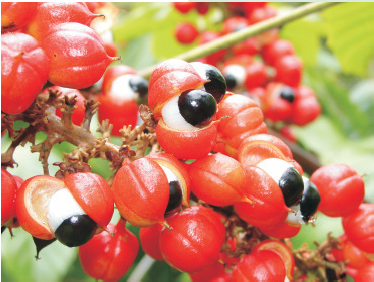Guarana extract powder
Guarana

Guarana (/ɡwəˈrɑːnə/ from the Portuguese guaraná [ɡwaɾɐˈna]), Paullinia cupana, syn. P. crysan, P. sorbilis) is a climbing plant in the maple family, Sapindaceae, native to the Amazon basin and especially common in Brazil. Guarana features large leaves and clusters of flowers, and is best known for the seeds from its fruit, which are about the size of a coffee bean. As a dietary supplement, guarana is an effective stimulant: its seeds contain about twice the concentration of caffeine found in coffee seeds (about 2–4.5% caffeine in guarana seeds compared to 1–2% for coffee seeds).
As with other plants producing caffeine, the high concentration of caffeine is a defensive toxinthat repels herbivores from the berry and its seeds.
The guarana fruit's colour ranges from brown to red and contains black seeds which are partly covered by white arils. The colour contrast when the fruit has been split open has been likened to eyeballs; which has formed the basis of an origin myth among the Sateré-Mawé people.
History and culture
The word guarana comes from the Guaraní word guara-ná, which has its origins in the Sateré-Mauéword for the plant, warana, that in Tupi-Guarani means "fruit like the eyes of the people"
Guarana plays an important role in Tupi and Guaraní Paraguayan culture. According to a myth attributed to the Sateré-Maué tribe, guarana's domestication originated with a deity killing a beloved village child. To console the villagers, a more benevolent god plucked the left eye from the child and planted it in the forest, resulting in the wild variety of guarana. The god then plucked the right eye from the child and planted it in the village, giving rise to domesticated guarana.
The Guaranís would make an herbal tea by shelling, washing and drying the seeds, followed by pounding them into a fine powder. The powder is kneaded into a dough and then shaped into cylinders. This product is known as guarana bread, which would be grated and then immersed into hot water along with sugar.
This plant was introduced to European colonizers and to Europe in the 16th century by Felip Betendorf, Oviedo, Hernández, Cobo and other Spaniard chroniclers. By 1958, guarana was commercialized.
Composition
The table contains a partial listing of some of the chemicals found in guarana seeds,although other parts of the plant may contain them as well in varying quantities.
According to the Biological Magnetic Resonance Data Bank, guaranine (better known ascaffeine) is found in guarana, and is identical to caffeine derived from other sources, like coffee, tea, and mate. Guaranine, theine, and mateine are all synonyms for caffeine when the definitions of those words include none of the properties and chemicals of their host plants except caffeine.Natural sources of caffeine contain widely varying mixtures of xanthine alkaloids other than caffeine, including the cardiac stimulants theophylline and theobromine and other substances such aspolyphenols, which can form insoluble complexes with caffeine. The mainnatural phenols found in guarana are (+)-catechin and (-)-epicatechin.
Uses
Guarana is used in sweetened or carbonated soft drinks and energy shots, an ingredient of herbal teas or contained in capsules. Generally, South America obtains most of its caffeine from guarana.




 淘宝旺旺
淘宝旺旺
